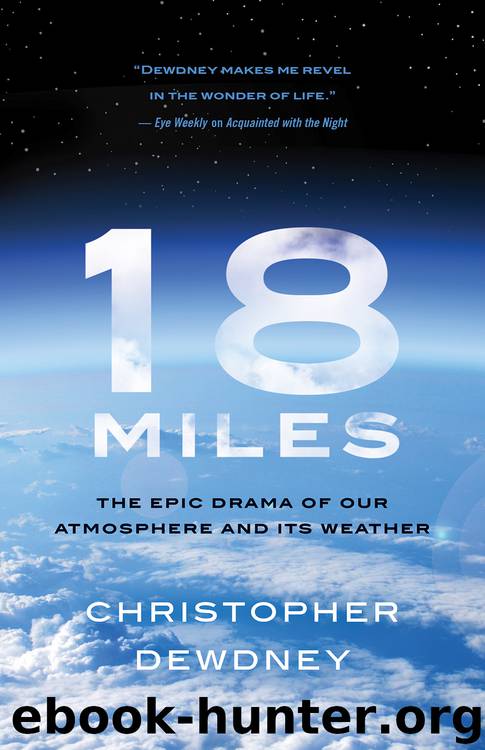18 Miles by Christopher Dewdney

Author:Christopher Dewdney
Language: eng
Format: epub
Publisher: ECW Press
Published: 2018-10-22T16:00:00+00:00
The Invention of the Barometer
In 1608, Galileo Galilei heard about a spectacle maker in Holland who had fashioned an arrangement of lenses with the remarkable power of making distant things appear closer. He reproduced the arrangement on his own in Pisa and then, seeing room for improvement, built the world’s first astronomical telescope, turned it on the moon and became the first human being to see lunar mountains. Looking at Jupiter, he discovered that it was orbited by several moons. Everywhere he turned his telescope in the night sky was bristling with stars and nebulae, and everything in this newly immense universe confirmed Copernicus’s heretical assertion that the Earth orbited the sun, not the other way around. There was a big party going on out there, and the Vatican was not invited. All this was plain for anyone with a telescope.
But Earth’s atmosphere had yet to be fully understood. Air was thought to be weightless, and anything less than air was deemed to be impossible. Aristotle’s proclamation that nature abhors a vacuum was still regarded as a fundamental truth when, in 1630, a young scientist named Giovanni Battista Baliani wrote to his mentor, Galileo Galilei, concerning a problem he’d discovered with a siphon he had constructed to conduct water. He was using a suction pump to force water uphill, trying to ascertain just how high it could rise.
Baliani found that if the elevation of the transfer siphon reached a critical height, somewhere around 34 feet, the water stopped flowing. Something impeded it. Hence his letter. Galileo responded (years later in a 1638 publication) with two extraordinary speculations: not only did he acknowledge that a vacuum could exist (in the empty space at the top of Baliani’s siphon), he also asserted the vacuum wasn’t quite strong enough to raise the weight of the water above the 34-foot level.
Two years later, this speculation inspired two young scientists, Gasparo Berti and Raffaello Magiotti, to fill a 42-foot-long lead pipe with water and plug both ends. They then stood the tube in a water-filled basin and opened the bottom plug. Counter-intuitively the water in the cylinder didn’t entirely flow out. In fact, hardly any water spilled into the basin; the level inside the pipe had dropped only slightly. Because the upper end was sealed, there had to be a space at the top of the cylinder. What could be in that space? Had Berti and Magiotti succeeded in producing the very thing that nature abhored, something unnatural and yet so powerful it held up the column of water?
Evangelista Torricelli, a 32-year-old mathematician from Rome, applauded the experiment — the creation of the first generally recognized artificial vacuum — but he was more intrigued by the height of the water remaining in the tube. Berti and Magiotti estimated the level to be about 34 feet, the same as the height in Baliani’s tube. Why the consistency? In 1631, nine years earlier, René Descartes had theorized that air might have weight and further speculated that it might be possible to construct a device to measure it.
Download
This site does not store any files on its server. We only index and link to content provided by other sites. Please contact the content providers to delete copyright contents if any and email us, we'll remove relevant links or contents immediately.
How to Do Nothing by Jenny Odell(3232)
A Forest Journey by John Perlin(3027)
The Plant Messiah by Carlos Magdalena(2883)
Babylon's Ark by Lawrence Anthony(2620)
The ESV Study Bible by Crossway Bibles(2502)
Energy Myths and Realities by Vaclav Smil(2438)
Fatal Storm by Rob Mundle(2171)
Abbey in America by Murray John A(2049)
Witness Tree by Lynda V. Mapes(1887)
Brokeback Mountain by Annie Proulx(1782)
Client Earth by James Thornton(1733)
Shadows on the Gulf by Rowan Jacobsen(1717)
Coming Back to Life by Joanna Macy(1685)
Cosmos by Carl Sagan(1680)
Water Rights and the Environment in the United States by John Burch(1643)
Mycelium Running: How Mushrooms Can Help Save the World by Paul Stamets(1640)
Ten Billion by Stephen Emmott(1609)
The overachievers by Robbins Alexandra(1528)
Ecological Intelligence by Daniel Goleman(1507)
